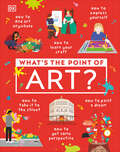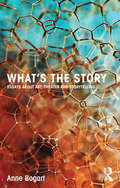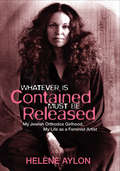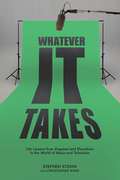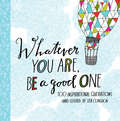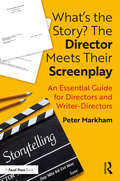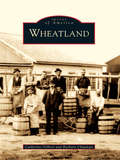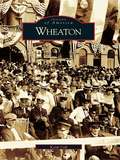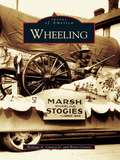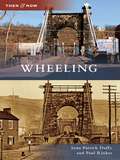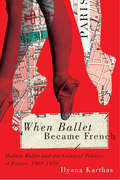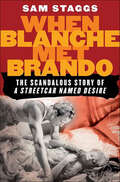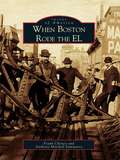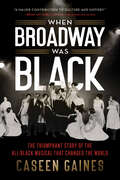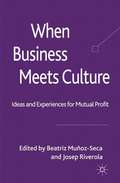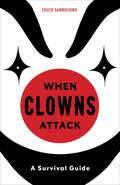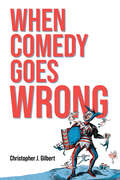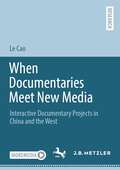- Table View
- List View
What's the Point of Art? (DK What's the Point of?)
by DKGet your paints and canvases ready for a fun-filled journey through art! Explore how artists get ideas and bring them to life, how art can affect the way we think and feel, and why people throughout history loved it so much.Why is art important? What's so great about it? In this illustrated book, you'll see the world through famous artists' eyes, and what inspired them to make art. And you'll use their techniques to produce your own masterpieces. Did you know that early humans spent a great deal of time on their cave paintings? Before cameras and smartphones were invented, people had paintings and drawings made of them to keep a record of what they looked like. Many artists, such as Vincent Van Gogh and Frida Kahlo, used art as a language to express their feelings, thoughts, and emotions in ways that words couldn't. Explore techniques you can use to create art, and you don't have to be good at drawing and painting to do it. If you want to learn why art has the power to be beautiful, shocking, entertaining, and even political, What's the Point of Art? is the place to start. This book is about how art has changed the world, one artistic movement at a time, and it is guaranteed to inspire, surprise, and entertain everyone who picks it up.
What's the Story: Essays about art, theater and storytelling
by Anne BogartAnne Bogart is an award-winning theatre maker, and a best-selling writer of books about theatre, art, and cultural politics. In this her latest collection of essays she explores the story-telling impulse, and asks how she, as a ‘product of postmodernism’, can reconnect to the primal act of making meaning and telling stories. She also asks how theatre practitioners can think of themselves not as stagers of plays but ‘orchestrators of social interactions’ and participants in an on-going dialogue about the future. We dream. And then occasionally we attempt to share our dreams with others. In recounting our dreams we try to construct a narrative... We also make stories out of our daytime existence. The human brain is a narrative creating machine that takes whatever happens and imposes chronology, meaning, cause and effect... We choose. We can choose to relate to our circumstances with bitterness or with openness. The stories that we tell determine nothing less than personal destiny. (From the introduction) This compelling new book is characteristically made up of chapters with one-word titles: Spaciousness, Narrative, Heat, Limits, Error, Politics, Arrest, Empathy, Opposition, Collaboration and Sustenance. In addition to dipping into neuroscience, performance theory and sociology, Bogart also recounts vivid stories from her own life. But as neuroscience indicates, the event of remembering what happened is in fact the creation of something new.
Whatever Is Contained Must Be Released: My Jewish Orthodox Girlhood, My Life as a Feminist Artist (Jewish Women Writers Ser.)
by Helène Aylon&‘[A] richly evocative, captivating, and reflective memoir&” of a feminist artist who broke free of the limits placed on her by family, Judaism and society (Publishers Weekly). Growing up an Orthodox Jew in Brooklyn, Helene Aylon spent her Friday nights in a sea of extended family as the Sabbath candles flickered. Passionate about art, she dreamt of escaping the strict, secular world of her youth, but instead married a rabbi and became a mother of two. Then, her world was split apart when her husband was diagnosed with cancer, and Aylon found herself widowed at thirty. Free to explore both her own soul and the changing world around her, Aylon sought a home in the burgeoning environmental art scene of the 1970s—creating transgressive works that explore identity, women&’s bodies, the environment, disarmament, and the notion of God. Finally, she dares to asks of Judaism: Where are the women? With many examples of her work included within, Whatever is Contained &”is an arresting tale of uncommon courage, intelligence, and wit&” following Aylon&’s search for truth in art, and the links between feminism and Judaism (Gail Levin, author of Lee Krasner: A Biography and Becoming Judy Chicago).
Whatever It Takes: Stories From A Life Behind The Scenes In The Music And Television Worlds
by Christopher Ward Stephen Stohn Martin GeroThis book will change the way you think about success. Producer of television’s iconic Degrassi franchise Stephen Stohn tells stories from behind the scenes and of making it in the music and television world in this star-studded, rock ’n’ roll trip through a Canadian show business explosion. Stohn, who has been at the heart of the entertainment industry for over forty years, shares a lifetime of experience and unique insights into how dreams are turned into reality. “Whatever It Takes” — both a mantra and Degrassi’s theme song — has been heard millions of times all over the world. It embodies a philosophy of struggle and self-belief leading to accomplishment, as well as the story of an exploring mind, an adventurous pursuit of experience, ringing failures, and the willingness to see things in a different way.
Whatever You Are, Be a Good One: 100 Inspirational Quotations Hand-Lettered by Lisa Congdon
by Lisa CongdonA quote book like no other, this thought-provoking collection compiles the timeless wisdom of great original minds— from Marie Curie to Stephen King, Joan of Arc to Jack Kerouac, Oscar Wilde to Harriet Tubman—brilliantly hand-lettered by beloved indie artist Lisa Congdon. Readers will find enlightening insights ("Wisdom begins in wonder"— Socrates), stirring calls to action ("Leap and the net will appear"—John Burroughs), and stimulating encouragements ("Be curious, not judgmental"—Walt Whitman) beautifully illuminated on every page. A delightful reminder to get out there and make the most of life, Whatever You Are, Be a Good One is perfect for recent graduates, creative thinkers, and anyone looking for a little inspiration.
What’s the Story? The Director Meets Their Screenplay: An Essential Guide for Directors and Writer-Directors
by Peter MarkhamA structured perspective on the crucial interface of director and screenplay, this book encompasses twenty-two seminal aspects of the approach to story and script that a director needs to understand before embarking on all other facets of the director’s craft. Drawing on seventeen years of teaching filmmaking at a graduate level and on his prior career as a director and in production at the BBC, Markham shows how the filmmaker can apply rigorous analysis of the elements of dramatic narrative in a screenplay to their creative vision, whether of a short or feature, TV episode or season. Combining examination of such fundamental topics as story, premise, theme, genre, world and setting, tone, structure, and key images with the introduction of less familiar concepts such as cultural, social, and moral canvas, narrative point of view, and the journey of the audience, What’s The Story? The Director Meets Their Screenplay applies the insights of each chapter to a case study—the screenplay of the short film Contrapelo, nominated for the Jury Award at Tribeca in 2014. This book is an essential resource for any aspiring director who wants to understand exactly how to approach a screenplay in order to get the very best from it, and an invaluable resource for any filmmaker who wants to understand the important creative interplay between the director and screenplay in bringing a story to life.
Wheatland (Images of America)
by Barbara Chapman Catherine GilbertThe town of Wheatland lies along the west bank of the Genesee River in the southwest corner of Monroe County. In 1786, the adventurous frontiersman Ebenezer "Indian" Allan built a log cabin near the river. The Allan family soon moved on, but the settlement of the entire area west of the Genesee River had begun. The name given to the town in 1821 recognized the successful wheat crops already yielded by its fertile soil. Oatka Creek, which winds its way across town to the river, once powered flour and plaster mills that made the villages and hamlets of Wheatland thriving communities. Today Wheatland remains a rural area known for its picturesque countryside and its recreational opportunities.
Wheaton
by Keith CallWhere will you find C. S. Lewis's wardrobe, J. R. R. Tolkien's desk, Malcolm Muggeridge's typewriter, Madame Blavatsky's tiara, the bones of a hulking mastodon, Billy Graham's traveling pulpit, and Tyndale House, publishers ofthe best-selling Left Behind series? Where will you find students, mystics, theologians, doctors, authors, actors, and musicians living in harmony? In Wheaton. Located 26 miles west of Chicago, the "All America City" boasts excellent schools, exquisite old homes, safe streets, and fine museums. Though Horace Greeley is credited with uttering the immortal "Go west, young man!" the sentiment had been acted upon much earlier by questing pioneers, many of whom halted in the middle plains, sensing terrific potentialin the rich black soil of Illinois. Among these were Warren and Jesse Wheaton and Erastus Gary from Pomfret, Connecticut. Seeking suitable land for farming, they settled and constructed a mill. From there they built cabins and harvested spring crops. Soon there was a village of a few hundred, connected by train to the farthest reaches of the nation. Now there is a city of 55,000 residents.
Wheelchair Housing Design Guide
by Centre For (Cae)The Wheelchair Housing Design Guide explains how to design and detail a home that is fully manageable by wheelchair users and maximises their independence. This fully-updated, activity-based guide discusses design considerations, requirements and recommendations for various activities carried out within the home; provides design solutions and good practice examples of how to comply with the building accessibility regulations and Building Regulations Part M; reflects and promotes the values and principles of existing strategies for social inclusion, and promotes the long-term cost benefits of designing to wheelchair accessibility standards.
Wheeling
by Brent Carney William A. Carney Jr.When most people think of Wheeling they remember Independence Hall and the birth of West Virginia, but Wheeling's history goes back even further to the frontier legends of Lewis Wetzel and Maj. Samuel McColloch. Images of America: Wheeling includes photographs of both Wetzel's cave and Major McColloch's smoke house, as well as a multitude of historic photographs depicting the way life used to be in the late 19th and early 20th centuries.Famous visitors such as Babe Ruth, Franklin D. Roosevelt, Charles Lindbergh, President John F. Kennedy, actress Sarah Bernhardt, and Buffalo Bill are featured. Within these pages memorable snapshots document some famous moments in the history of the 20th century, such as when President Eisenhower decided to keep Senator Nixon on the ticket at the Ohio County Public Airport and Sen. Joseph McCarthy's famous speech about Communists in the State Department at Wheeling's McLure Hotel. However, the real stars of this book are Wheeling's own buildings, industries, and people, from machine workers on the job to millionaires at play. A chapter devoted to the African-American experience in Wheeling includes Center Market's slave auction block as well as an image of the great jazz saxophonist Leon "Chu" Berry. This collection highlights some of the horrific natural disasters that occurred at the turn of the century as well as Wheeling's Victorian architectural treasures, which were erected during the same era.
Wheeling
by Sean Patrick Duffy Paul RinkesThe convergence of the Ohio River, the National Road, a remarkable bridge, and the Baltimore and Ohio Railroad transformed Wheeling into a transportation hub. Fed by an influx of immigrant labor, the city prospered, adding industrial muscle. But global economic changes brought the machine to a sudden halt. In Then & Now: Wheeling author Seán Duffy and photographer Paul Rinkes explore a city still recovering from that trauma, a city with a proud past and an uncertain but hopeful future.
When Ballet Became French
by Ilyana KarthasFor centuries before the 1789 revolution, ballet was a source of great cultural pride for France, but by the twentieth century the art form had deteriorated along with France's international standing. It was not until Serge Diaghilev's Ballets Russes found success in Paris during the first decade of the new century that France embraced the opportunity to restore ballet to its former glory and transform it into a hallmark of the nation. In When Ballet Became French, Ilyana Karthas explores the revitalization of ballet and its crucial significance to French culture during a period of momentous transnational cultural exchange and shifting attitudes towards gender and the body. Uniting the disciplines of cultural history, gender and women's studies, aesthetics, and dance history, Karthas examines the ways in which discussions of ballet intersect with French concerns about the nation, modernity, and gender identities, demonstrating how ballet served as an important tool for France's project of national renewal. Relating ballet commentary to themes of transnationalism, nationalism, aesthetics, gender, and body politics, she examines the process by which critics, artists, and intellectuals turned ballet back into a symbol of French culture. The first book to study the correlation between ballet and French nationalism, When Ballet Became French demonstrates how dance can transform a nation's cultural and political history.
When Ballet Became French: Modern Ballet and the Cultural Politics of France, 1909-1958
by Ilyana KarthasFor centuries before the 1789 revolution, ballet was a source of great cultural pride for France, but by the twentieth century the art form had deteriorated along with France's international standing. It was not until Serge Diaghilev's Ballets Russes found success in Paris during the first decade of the new century that France embraced the opportunity to restore ballet to its former glory and transform it into a hallmark of the nation. In When Ballet Became French, Ilyana Karthas explores the revitalization of ballet and its crucial significance to French culture during a period of momentous transnational cultural exchange and shifting attitudes towards gender and the body. Uniting the disciplines of cultural history, gender and women's studies, aesthetics, and dance history, Karthas examines the ways in which discussions of ballet intersect with French concerns about the nation, modernity, and gender identities, demonstrating how ballet served as an important tool for France's project of national renewal. Relating ballet commentary to themes of transnationalism, nationalism, aesthetics, gender, and body politics, she examines the process by which critics, artists, and intellectuals turned ballet back into a symbol of French culture. The first book to study the correlation between ballet and French nationalism, When Ballet Became French demonstrates how dance can transform a nation's cultural and political history.
When Blanche Met Brando: The Scandalous Story of A Streetcar Named Desire
by Sam StaggsExhaustively researched and almost flirtatiously opinionated, When Blanche Met Brando is everything a fan needs to know about the ground-breaking New York and London stage productions of Williams' "Streetcar" as well as the classic Brando/Leigh film. Sam Staggs' interviews with all the living cast members of each production will enhance what's known about the play and movie, and help make this book satisfying as both a pop culture read and as a deeper piece of thinking about a well-known story. Readers will come away from this book delighted with the juicy behind-the-scenes stories about cast, director, playwright and the various productions and will also renew their curiosity about the connection between the role of Blanche and Viven Leigh's insatiable sexual appetite and later descent into breakdown. They may also-for the first time-question whether the character of Blanche was actually "mad" or whether her anxiousness was symptomatic of another disorder."A Streetcar Named Desire" is one of the most haunting and most-studied modern plays. Staggs' new book will fascinate fans and richen newcomers' understanding of its importance in American theater and movie history.
When Boston Rode the EL
by Frank Cheney Anthony Mitchell SammarcoThe Boston Elevated Railway broke ground in 1899 for a new transit service that opened in 1901, providing a seven-mile elevated railway that connected Dudley Street Station in Roxbury and Sullivan Square Station in Charlestown, two huge multilevel terminals. When the EL, as it was popularly known, opened for service, it provided an unencumbered route high above the surging traffic of Boston, until it went underground through the city. The new trains of the EL were elegant coaches of Africanmahogany, bronze hardware, plush upholstered seats, plate glass windows, and exteriors of aurora red with silver gilt striping and slate grey roofs. They stopped at ten equally distinguished train stations, designed by the noted architect Alexander WadsworthLongfellow. All of this elegance, let alone convenience, could be had for the price of a five-cent ticket. The popularity of the EL was instantaneous. The railway continued to provide transportation service high above Boston's streets until 1987, when it was unfortunately ended after 86 years of elevated operation. Today, the squealing wheels of the Elevated trains, the rocking coaches, the fascinating views, and the fanciful copper-roofed stations of the line are a missing part of the character of Boston, when one could ride high above the city for a nickel.
When Broadway Was Black: The Triumphant Story of the All-Black Musical that Changed the World
by Caseen GainesThe triumphant story of how an all-Black Broadway cast and crew changed musical theatre—and the world—forever."This musical introduced Black excellence to the Great White Way. Broadway was forever changed and we, who stand on the shoulders of our brilliant ancestors, are charged with the very often elusive task of carrying that torch into our present."—Billy Porter, Tony, Grammy, and Emmy Award-winning actor"The 1920s were the years of Manhattan's Black Renaissance. It began with Shuffle Along." —Langston HughesIf Hamilton, Rent, or West Side Story captured your heart, you'll love this in-depth look into the rise of the 1921 Broadway hit, Shuffle Along, the first all-Black musical to succeed on Broadway. No one was sure if America was ready for a show featuring nuanced, thoughtful portrayals of Black characters—and the potential fallout was terrifying. But from the first jazzy, syncopated beats of composers Noble Sissle and Eubie Blake, New York audiences fell head over heels.When Broadway Was Black is the story of how Sissle and Blake, along with comedians Flournoy Miller and Aubrey Lyles, overcame poverty, racism, and violence to harness the energy of the Harlem Renaissance and produce a runaway Broadway hit that launched the careers of many of the twentieth century's most beloved Black performers. Born in the shadow of slavery and establishing their careers at a time of increasing demands for racial justice and representation for people of color, they broke down innumerable barriers between Black and white communities at a crucial point in our history.Author and pop culture expert Caseen Gaines leads readers through the glitz and glamour of New York City during the Roaring Twenties to reveal the revolutionary impact one show had on generations of Americans, and how its legacy continues to resonate today.Praise for When Broadway Was Black:"A major contribution to culture."—Brian Jay Jones, New York Times bestselling author of Jim Henson: The Biography"With meticulous research and smooth storytelling, Caseen Gaines significantly deepens our understanding of one of the key cultural events that launched the Harlem Renaissance."—A Lelia Bundles, New York Times bestselling author of On Her Own Ground: The Life and Times of Madam C.J. Walker"Absorbing..."—The Wall Street JournalPreviously published as Footnotes: The Black Artists Who Rewrote the Rules of the Great White Way
When Business Meets Culture: Ideas and Experiences for Mutual Profit
by Beatriz Muñoz-Seca Josep RiverolaThe cultural sector is gaining increasing importance in our economies, consistantly registering growth rates above average GDP. This book presents insights on how cultural institutions can find new perspectives in their management and provides ideas to hasten culture's role as an economic developer.
When Clowns Attack
by Chuck SambuchinoTHEY'RE COMING FOR YOU Coulrophobia--the fear of clowns--is very real and for good reason. You might think these red-nosed jokers are creepy, sure, but certainly not dangerous. You'd be wrong. Clowns never reveal their real names, and dress to obscure their identities. The rules of civilized society don't apply to them (what other stranger could offer candy to children and get away with it?), they have countless places to hide weapons on their person, and their appearance is downright unnatural. Clowns are the scariest people on earth, and the truth is, they are coming for your valuables, your children, and your sanity. In this comprehensive guide to self-protection from clown creepery, petty crime, and violence, Chuck Sambuchino--founder of the anti-clown group Red Nose Alert--delves into the terrifying clown underworld to provide the knowledge you need to know to protect yourself from these seemingly innocuous gagmen, using his proven four-step system: ASSESS, ANALYZE, DEFEND, PROTECT. Included within are instructions on how to defeat a clown in close combat, tips for spotting the plainclothes clown, and tutorials for fully clown-proofing your home against these painted and bewigged warriors. Most importantly, you'll learn what to do when clowns attack... because it's only a matter of time before they do.From the Hardcover edition.
When Comedy Goes Wrong (Comedy & Culture)
by Christopher J. GilbertWhile conventional wisdom has it that humor embodies a spirit of renewal and humility, a dispirited form of comedy thrives in a media-saturated and politically charged environment.When Comedy Goes Wrong examines how, beginning in the late-twentieth and carrying into the early twenty-first century, a certain comic dispirit found various platforms for disheartening cultural politics. From the calculated follies on talk radio programs like the Rush Limbaugh Show through the charades of "cancel culture" and ultimately to so-called Alt-Right comedy, the transgressions, improprieties, and ego trips endemic to a newfangled comic freedom produced entirely unfunny ways of being. To understand these unfunny ways, Christopher J. Gilbert challenges the prevailing belief in humor's goodness, analyzing radio personalities, meme culture, films, civil unrest, and even the language of ordinary individuals and everyday speech, all to demonstrate what happens when humor becomes humorless. As such, Gilbert imagines a nuanced sense of humor for a tumultuous world.Ultimately, When Comedy Goes Wrong transcends partisanship to explore the uglier parts of American culture, imagining the stakes of doing comedy—and being comical—as a means of survival.
When Did I See You Hungry?
by Gerard Thomas StraubThis book is about poverty and our responsibility to help those who are forced to live on the margins of society. The photographs in this book depict real people--suffering souls whose lives are spent in the harshly cruel prison of poverty. To look into their eyes, eyes that are profoundly human and tragically sad, compels the observer to want to do something to relieve the pain, to end the misery.
When Documentaries Meet New Media: Interactive Documentary Projects in China and the West
by Le CaoNew media and digital technologies open up numerous possibilities to document different versions of reality, which makes it essential to examine how they transform the logic behind the creation and production of documentaries in digital cultures. This study aims to investigate the integration between the traditional documentary and new media: the interactive documentary, in the context of the different sociocultural and technological environments of China and the West. Accordingly, a comparative study on the evolution and integration of these two fields was carried out. The documentary genre brings with it a method of classification and various modes of representing reality, while new media provide new approaches to interactivity as well as the production and distribution of interactive documentaries. Interactive documentaries grow and change as a continuously evolving system, engaging the roles of the author and the user, such that their roles are mixed for better co-expression and the reshaping of their shared environment. In addition, an analytical approach based on the types of interactivity was adopted to explore this new form of documentary; both to deduce how the stories about our shared world can be told and to understand the impact of interactive documentaries on the construction of our versions of the reality as well as our role in it.
When Eero Met His Match: Aline Louchheim Saarinen and the Making of an Architect
by Eva HagbergA uniquely personal biographical account of Louchheim’s life and work that takes readers inside the rarified world of architecture mediaAline B. Louchheim (1914–1972) was an art critic on assignment for the New York Times in 1953 when she first met the Finnish-American architect Eero Saarinen. She would become his wife and the driving force behind his rise to critical prominence. When Eero Met His Match draws on the couple’s personal correspondence to reconstruct the early days of their thrilling courtship and traces Louchheim’s gradual takeover of Saarinen’s public narrative in the 1950s, the decade when his career soared to unprecedented heights.Drawing on her own experiences as an architecture journalist on the receiving end of press pitches and then as a secret publicist for high-end architects, Eva Hagberg paints an unforgettable portrait of Louchheim while revealing the inner workings of a media world that has always relied on secrecy, friendship, and the exchange of favors. She describes how Louchheim codified the practices of architectural publicity that have become widely adopted today, and shows how, without Louchheim as his wife and publicist, Saarinen’s work would not have been nearly as well known.Providing a new understanding of postwar architectural history in the United States, When Eero Met His Match is both a poignant love story and a superb biographical study that challenges us to reconsider the relationship between fame and media representation, and the ways the narratives of others can become our own.
When Everybody Wore a Hat
by William SteigFrom the book: This is the story of when I was a boy, almost 100 years ago, when fire engines were pulled by horses, boys did not play with girls, kids went to libraries for books, there was no TV, you could see a movie for a nickel, and everybody wore a hat.
When Frankie Went to Hollywood: Frank Sinatra and American Male Identity
by Karen McnallyThis first in-depth study of Frank Sinatra's film career explores his iconic status in relation to his many performances in postwar Hollywood cinema. When Frankie Went to Hollywood considers how Sinatra's musical acts, television appearances, and public commentary impacted his screen performances in Pal Joey, The Tender Trap, Some Came Running, The Man with the Golden Arm, and other hits. A lively discussion of sexuality, class, race, ethnicity, and male vulnerability in postwar American culture illuminates Karen McNally's investigation into Sinatra's cinematic roles and public persona. This entertainment luminary, she finds, was central in shaping debates surrounding definitions of American male identity in the 1940s and '50s.
When Glitter Met Glue (When Pencil Met Eraser)
by Karen KilpatrickThe third hilarious picture book in the award-winning When Pencil Met Eraser series in which underappreciated Glue longs to stand out, and soon meets a new friend, Glitter, who helps bring out her inner sparkle, confidence, and creativity. Glue loves making art with her friends—especially pasting on googly eyes!—but sometimes she feels invisible. Instead of always being stuck in the background, Glue wants to be noticed like Pencil and colorful like the Markers! How can she find a way to stand out?When a new friend named Glitter arrives in a swirl of sparkles, Glue and Glitter team up to make something completely original and help Glue shine like the star she truly is.Karen Kilpatrick & Germán Blanco's When Glitter Met Glue spotlights art’s unsung hero—a glue bottle—in a hilarious and clever story that encourages creativity, self-acceptance, and spurs us all to recognize our inner shimmer.
